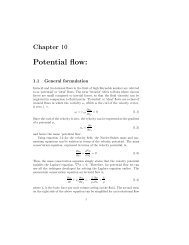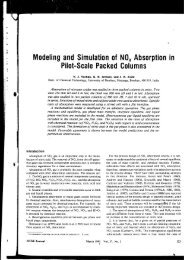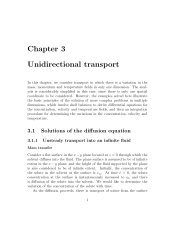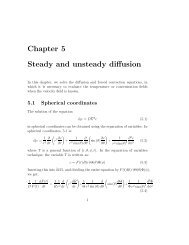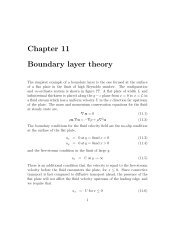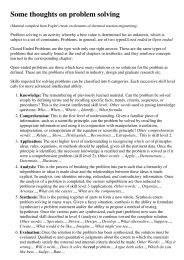Create successful ePaper yourself
Turn your PDF publications into a flip-book with our unique Google optimized e-Paper software.
20 CHAPTER 9. VISCOUS FLOW<br />
while the pressure field is given by equation .<br />
The response to an antisymmetric force dipole can be related to the torque<br />
exerted by the particle on the fluid, which is defined as,<br />
L i =<br />
∫<br />
S<br />
∫<br />
dSǫ ijk x j f k<br />
= 1 dSǫ ijk (x j f k − x k f j )<br />
2 S<br />
= ǫ ijk Djk A (9.80)<br />
where Djk A is the antisymmetric force dipole moment exerted by the particle.<br />
The torque is related to the angular velocity by equation , while the pressure<br />
is zero. Substituting for the particle velocity in terms of the torque, we<br />
obtain,<br />
9.2.3 Faxen’s laws<br />
u i = − ǫ ijkL j<br />
8πµ<br />
( xk<br />
r 3 )<br />
p = 0 (9.81)<br />
Faxen’s laws provide the velocity of a particle which is placed in some imposed<br />
<strong>flow</strong> field U ∞ (x). We have studied examples where the imposed <strong>flow</strong> field has<br />
a specific form; in section , the imposed <strong>flow</strong> field is a constant streaming<br />
<strong>flow</strong> around the particle, while in section , the imposed <strong>flow</strong> field is a linear<br />
shear <strong>flow</strong>. In this section, we examine the response of a spherical particle<br />
to an arbitrary imposed <strong>flow</strong> field, U ∞ (x), which is the velocity field at a<br />
large distance from the particle. This is a first step towards understanding<br />
inter-particle interactions, because if we know how the particle reacts to some<br />
imposed <strong>flow</strong> field, we can infer how it would react to the velocity disturbance<br />
caused by a second particle.<br />
The fluid velocity field due to a particle in the <strong>flow</strong> field U ∞ (x) can be<br />
expressed in terms of the surface forces using the Oseen tensor,<br />
u i (x) = U ∞ i (x) +<br />
= U ∞ i (x) +<br />
∫ ′<br />
S<br />
∫ ′<br />
S<br />
dS ′ J ij (x − x ′ )f j (x ′ )<br />
dS ′ J ij (x − x ′ )τ jk (x ′ )n ′ k (9.82)<br />
where x ′ is a point on the surface of the particle, S ′ is the surface of the<br />
particle and n ′ is the unit normal to the surface at the position x ′ . Equation<br />
also applies to the fluid velocity at the surface of the particle. The fluid





